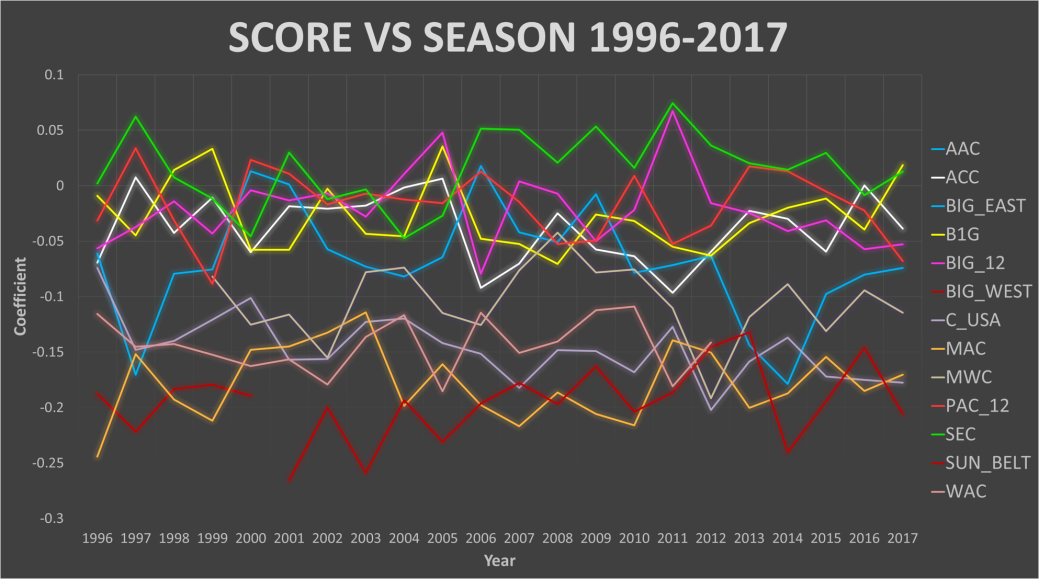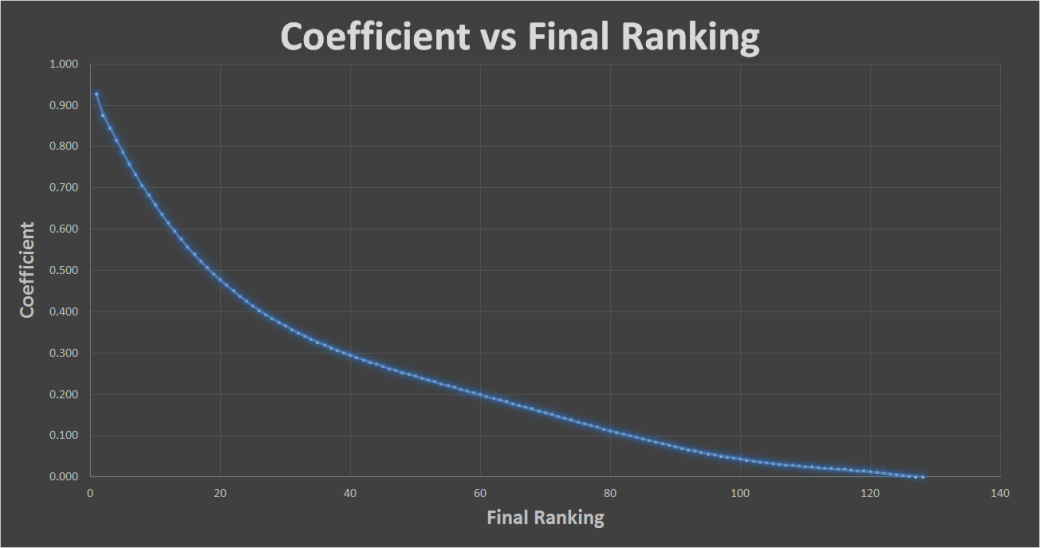No System is Perfect
If all 128 some odd FBS teams were able to play each other Home, Away and at a Neutral site, there would be very little controversy surrounding which team and which conference was the best in the land. The results would speak for themselves. However, the season isn’t 381 games long, so we have to use the data available to us.
Many models, such as the Jeff Sagarin’s College Football Ratings rank the teams on paper and then average them together, usually weighing the middle of the conference the most. This method may seem just as legitimate as any other, but the human element seems to be too dominant of a factor, and the weighting seems to favor simplicity of calculation over rationality. Why should the exact middle of a 14 team conference(7th and 8th) be 7 times as much as the top team? And why should the exact middle of a 10 team conference(5th and 6th) be 5 times as much as the top team? 1-2-3-4-5-6-7-7-6-5-4-3-2-1 and 1-2-3-4-5-5-4-3-2-1 is pretty to look at and easy to calculate, but it doesn’t make much sense.
One of the initial, and most important mechanisms of the SCFB system is that completely destroys the “overrated in the polls” conflict. Since the polls are at the heart of the final coefficient values, getting it right seems of vital importance. Over ranking and biases to give each of a certain pollster of computer formulas would seem on the surface to be a huge issue, much like it is for Sagarin’s Ratings. For example, one of the many arguments lobbied against the SEC is that they are overrated in the preseason and when they lose, they don’t fall in the polls. Jeff Sagarin’s Ratings would be incredibly susceptible to this. Well this system would punish the SEC severely for such a bias. All their losses would overvalued and all their wins would then be undervalued. Any time a Pac-12 or a B1G team plays an SEC team in a bowl game or out of conference, their interests are best served if that SEC was ranked as highly as possible. If the SEC squeaked by, and the Pac-12 or B1G team was ranked too lowly, the SEC wouldn’t be rewarded as much as they should have been, and the Pac-12 or B1G wouldn’t be punished as much as they should have been. And vice versa. This creates the perfect motivation to “get it right” with the pollsters and rankings.
Every. Game. Matters.
The premise is simple. Wins against good teams are the best. Losses against good teams aren’t that bad. Wins against bad teams really aren’t that great. Losses against bad teams are the worst. This system prioritizes this above all else. While a completely merit driven system isn’t possible, a reasonably merit driven system is definitely possible.
Base Assumptions
Final Ranks
Currently this is a combination of Massey Ratings, ESPN’s FPI, the Final AP Poll, and the Final Coaches Poll. It’s important to use an aggregate, as rankings even beyond the top 25 need to be accurate. It’s also why I believe the committee and polling system is still important.
Unlike a conference rating system that simply aggregates a paper ranking, this system is fundamentally merit based, but it needs to have paper rankings in lieu of standings to determine exactly what that merit is.
Based on fifteen years of Final Rankings, the historical win percentage against every FBS team in the Final Rankings, the coefficient for defeating an opponent is as follows:
The shape of this curve represents historical data from the past 10 seasons and it should change slightly as parity increases or decreases, but it should always be a reasonable representative of the relatively difficulty of each opponent. The range of historical data that needs to used to maintain both enough data to be accurate as well as recently enough to maintain maximum relevance and current trends.
Basic Multipliers
Home, away and neutral each have different values. A road win worth the most. A home loss hurts the most.
| FBS_WIN_MULTIPLIER | 1 |
| FBS_TIE_MULTIPLIER | 0.5 |
| FBS_LOSS_MULTIPLIER | -1 |
| HOME_MULTIPLIER | 0.45 |
| AWAY_MULTIPLIER | 0.55 |
| NEUTRAL_MULTIPLIER | 0.5 |
What about the FCS?
This is a tricky subject. Some schools and conferences want to eliminate FCS games all together, others want the easy win given how difficult their schedule is. But there are there are also political and financial reasons that make it much more complicated than just, “scheduling a cupcake”. Mark Richt, for example, would like to have an FCS team a part of every schedule.
“I might have a different opinion than other people but I’m on the board of trustees for the American Football Coaches Association, so not only are there FBS coaches that represent but there are also FCS coaches that represent on the board for different levels of ball,” Richt said. “The American Football Coaches Association is about football in America, basically ? college football, and high school, in America, just the health of the game and all that kind of thing. So you sit in the room and you hear some of the FCS coaches say that if no one would play them from the FBS and the types of paydays they get, then they would really worry about whether or not they could sustain their programs.”
As North Dakota State’s recent dominance of the Big 12 indicates, some of those “rent-a-wins” aren’t really “rent-a-wins” at all. Given some schools jumps from the FCS to the FBS, or even from the FBS to the FCS, an initial parameter that would mean eliminating FCS opponents, regardless of how much more simpler it would make this process, is simply unrealistic.
This biggest issue is that while a large majority of FCS teams are simply not competitive at all compared to the top end of the FBS, and others have proven to be more than competitive against even historic powers, there simply aren’t enough games. Many might say that the historic powers, with permanent rivals that are also extremely competitive, shouldn’t have to worry about scheduling the varying degrees of the weaker FCS teams, and should be afforded a reasonable expectation to do so without conflicting interests arising. Alabama, which is likely to beat whichever FCS team it wants to, but also doesn’t want to schedule and up and coming program, shouldn’t have to worry about scheduling the 30th best FCS team over the 70th. With historic and regional ties to consider, it doesn’t make sense to discourage anything but a major program scheduling whichever FCS team is the most convenient. We also don’t want to discourage the rest of the FBS, especially those more likely to lose to the FCS, from scheduling whichever FCS team they want. A school like Kansas might see individual financial reward from scheduling a school like North Dakota State which they didn’t know would be good enough to win the FCS Championship, and even with the higher than average probability of an FCS loss, it shouldn’t be discouraged from doing so. Kansas might lose 1 out of 20 to a North Dakota State type of school, and we don’t need to negatively impact them beyond reason for scheduling well. On the other end, Alabama might not want the headache of worrying about a North Dakota State, but it doesn’t need a complicated formula that causes them to avoid the Jacksonville State Gamecocks or the Alabama State Hornets simply because playing the Northern Arizona Lumberjacks would make a more a reasonable opponent based on recent performance. If one of those teams is special that year, sure, but the assumed parity in the FCS, beyond the best of the best, is reasonable.
A way around this would be to skew wins of the top end teams towards lower end FBS opponents, and increase the parity of a win against the rest of the FCS squads. Losses against FCS opponents, however would not mirror the wins the same way they do in the FBS. With a more dramatic fall off that stabilizes more quickly we can give incentive to teams to not stress which middle to lower tier opponent they want.
Recently, we have seen teams transition from FCS to FBS and they routinely rank around 70th overall for the high end, and in the 120s on the middle end. In order to see a sharper falloff between teams, to mimic the current FBS rankings, and to make the top ranked FCS team roughly equivalent to the 72nd/73rd ranked FBS team, the following multipliers are applied. An additional FCS Multiplier, as well as a slight manipulation to the FBS coefficient and we can get a workable answer.
| FCS_MULTIPLIER | 0.2 |
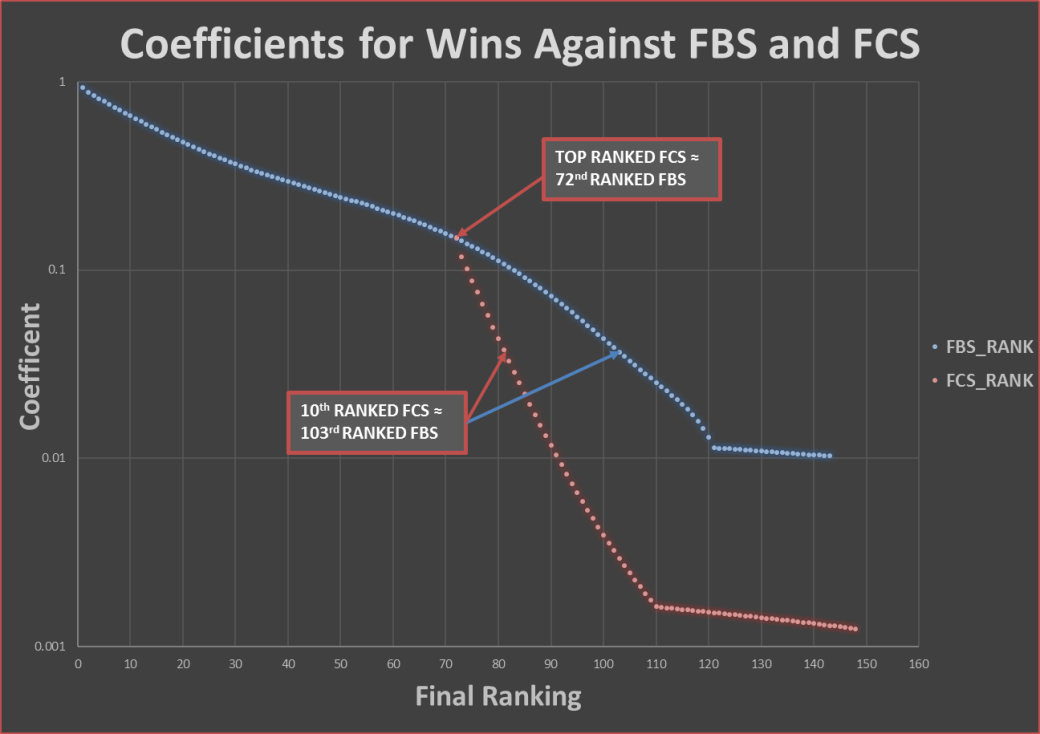 The Resulting Win and Loss Coefficients are as follows. Note: the axis scales are adjusted as necessary for clarity.
The Resulting Win and Loss Coefficients are as follows. Note: the axis scales are adjusted as necessary for clarity.
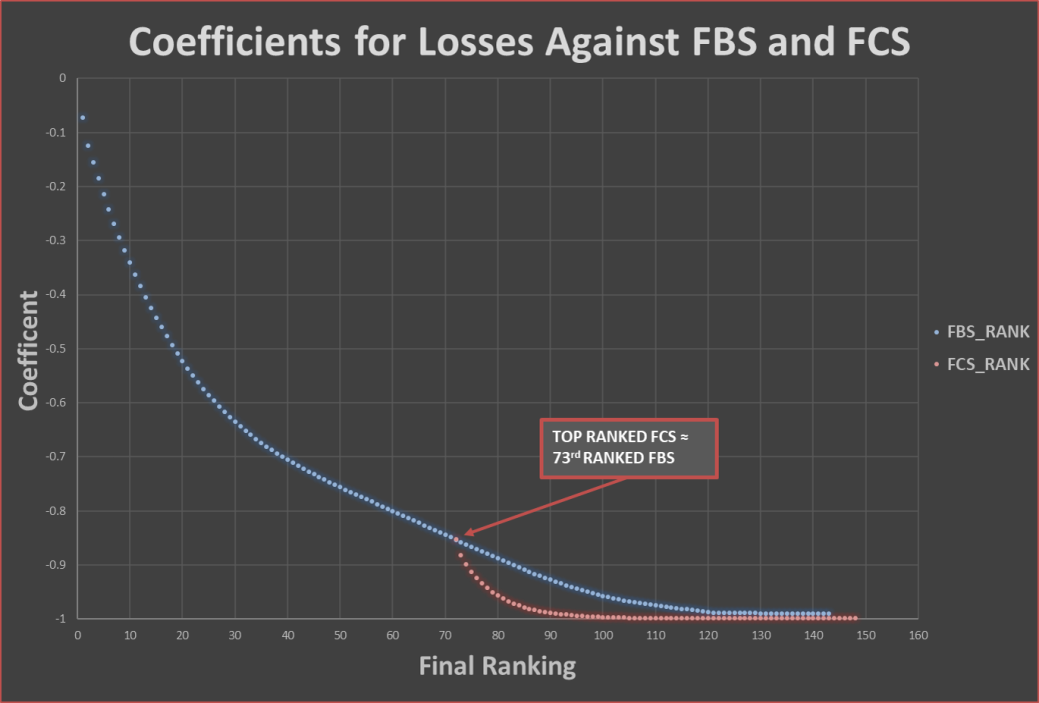
As you can see, this creates somewhat of a workable scenario. A win against a team that makes the FCS Playoffs is somewhere in the range of a win against a FBS team that isn’t bowl eligible. An FCS loss, excluding the FCS Champion, is worse than any FBS loss. A lot worse. We will have to find if that risk is overly detrimental, but the overall mechanics of that risk is reasonable.
Additional Considerations
The system also needs to be able to adjust to the real world implications that universities, athletic directors, and conference commissioners will face. Some concerns are obviously more valid than others, and some may not be valid at all, but we need to explore issues from all angles. Can the system be exploited? Are the teams in one conference systematically disadvantaged compared to another based on things like the number of members, classification of permanent rivals, or number of conference games? Does the system reward teams for the right things? Does it achieve it’s objectives? What are some areas we can expand and improve the formula?
Ranking Bias
As has previously been mentioned, this system punishes teams for being over ranked. This in itself is a good motivation for ranking correctly and eliminating biases, but it also presents an opportunity for continued error. A way to counteract this phenomenon is to minimize the impact of poor rankings with a ranking bonus or modifier. Since the system has the ability to lower the conference rank because teams are over ranked, and not the other way around, a final rank bonus or multiplier would counteract or dampen this phenomenon.
Bowl Season
A main objective of this system is to increase the relevance of every game, especially the Bowls. Given that teams schedule different numbers of games in the regular season, and bowls have varying levels of significance and importance, we can carry over this concept to a tangible benefit in the system. But this presents a few more questions.
How Much Should Bowl Season “Weigh”?
The impact of Bowl Season should be significant, but it shouldn’t be to a point where it outweighs or diminishes the regular season. It needs to be able to properly reward both and do so in a way that avoids any of the previously mentioned pitfalls such as adding inherent reward based on the conference size, number of out of conference games played in the regular season, individual teams scheduling formats and preferences, or even the number of teams that make bowl season, which is impacted by any number of these.
How Much Should Each Bowl Be “Worth”?
This is a different concept than how much the entire Bowl Season should weigh. For example, beating the 15th ranked team in a major bowl, if all bowls had the same “worth”, would be no different than beating them in a minor bowl. Meaning, the loser of the National Championship isn’t always ranked 2nd in the final standings, but winning the National Championship shouldn’t be diminished because the pollsters got it wrong or an upset happened the round before. The system should recognize each tier and be able to properly reward each win, even accounting for a wide and expected variance in the ranks of opponents.
This system proposes a 4 round playoff and 4 additional tiers of bowls. The current system does not have as many “tiers”, but some obvious levels of “prestige” do exist beyond the New Years Six and Playoff Games, simply by Bowl selection order and conference affiliation. By using the CFP years and the BCS years, we can derive a minimum and a maximum range that represents a logical result, and interpolate from there to find practical answers that reveal added context to the past, and the possibilities for ranking in the future.
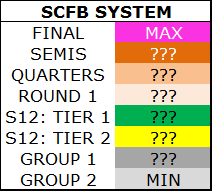
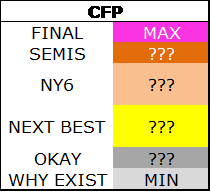
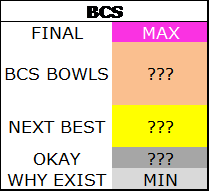
If we say the minimum individual value of a Bowl Game should be equivalent to a normal neutral site game, and each successive increase in Bowl prestige should be just large enough that a normal variance in standings of the defeated opponent will still produce a more valuable coefficient for the victor, you could end up with something roughly like this:
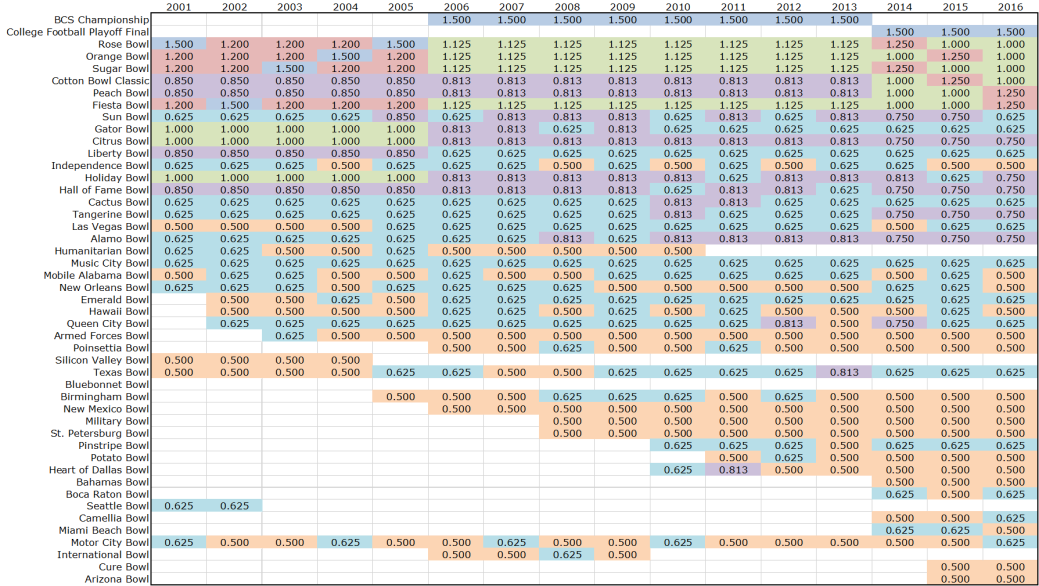
With a 0.5 multiplier on the low end, a Bowl Game that is between two G5 teams that are barely bowl eligible have the same individual weight as a neutral site out of conference game. Is a 1.5 multiplier for the Championship effective at allowing for the tiers to provide meaningful insight? Is it too high? Is it too low?
Scheduling Inequities
Different conferences have different schedules. This proposal shouldn’t aim to influence how a conference assembles itself or how it decides to determine a champion. Some schools have different scheduling demands with their out of conference schedules within the same conference. Some schools want to play FCS teams, some want to play more FBS teams. Some schools have tie ins with Power 5 teams and some with Group of 5 teams.
Strength of Schedule
Strength of schedule is built in to the coefficient to a large extent. Playing good teams and beating them is very rewarding. However, how difficult that schedule actually ends up being can vary from final standings, but some teams from the P5 and G5 might have inherently different difficulties and since each conference should not be forced to adopt a scheduling policy it doesn’t want, strength of schedule as an additional multiple or coefficient could be necessary.
Weighting Teams
A simple concept would be to say that every team is weighted equally in the final coefficient. Some say weight the top a little more and some weight the middle more. We need to determine if a weighting system has unintended or exploitable system.
Awards
All-Americans and National Award Winners can also be an indicator of conference strength. Playing All-Americans and National Award winners week in and week out can take a toll. It can also add national intrigue and a desire for fair assessment in the award selection process. This isn’t going to be in the system for the time being, but it is an interesting concept that I don’t think should be immediately dismissed.
Eliminating Systematic Bias
Risk and reward have to make sense. If a system like this is ever adopted, it will obviously be audited by some of the smartest people and companies in the world. If a consulting firm designs a conference schedule to maintain reward without the associated risk, then Brad Pitt and Jonah Hill will be moving to Tuscaloosa and certainly be on Nick Saban’s staff.

Bowl Losses Reveal an Another Dilemma
How much Bowl Season weighs vs the Regular Season is one of the biggest calculations, as well as how much each individual Bowl weighs. It is fundamental to add relevance to Bowl Season, but it also reveals the biggest issue of this system. We absolutely want bigger games to mean more, especially in the regular season. We want a big win to tangibly move the conferences chances at securing a top seed forward. But what about the team that lost? Increasing the reward without increasing the risk to compensate, undermines the system. However, is increasing the risk appropriate?
A team could have played, and gone undefeated against, top notch regular season opponents, barely lost their Bowl Game, but still have a lower coefficient than a non-bowl eligible team, or even a team that that lost a lower tier Bowl against a worst opponent. Is this an issue? On it’s surface it would obviously seem like it would be a huge issue. A team earning a spot in the Sugar Bowl against a top 10 opponent, shouldn’t hurt their conference coefficient more than a loss to a team not even in the top 50, regardless of the outcome, right?
On the opposite end of that spectrum, if the associated reward with making a bowl game is so high, then scheduling tough opponents wouldn’t make any sense. Just making bowl season, even if you lost more than you’d won, would be the only goal, and undermine the system. The sole motivation would be to schedule as weak of teams as possible just for a chance of making the post season. Just one Bowl win would make it all worth it. The punishment for not making Bowl Season would dominate. It would be like counting cards in black jack. You know you’re due for some losses, but your wins are so great, none of those losses matter. Every team would be lining up to schedule as many poor FCS teams as possible. If every team in the conference is then motivated to schedule an FCS team, then the conference size and number of games in the schedule really matters because the associated reward with 1/4th of the schedule being an FCS opponent as opposed to 1/3rd, would be completely out of whack.
And what if that Sugar Bowl loss was the conferences only representative in Bowl Season? Should that loss individually stand on it’s own relative to another conference’s bowl coefficient that only performed in the lowest tier but had two wins? Or should each team average their individual score with their individual bowl score and then combine the teams. Is this even possible with different size conferences and number of games?
To avoid many of the issues presented, the goal needs to be maintaining a constant risk/return ratio for every single game. This way, the number of teams in each conference and the number of games played wouldn’t matter. But that might not make sense either.
For example, a 16 team conference with 3 out of conference games would have the exact same number of regular season games(48) as a 12 team conference with 4 out of conference games(48). If the total number of FCS and FBS teams for each conference is the same, then regardless of some teams possibly not playing an FCS opponent at all or even two or three times, the risk/return profile would be identical, and is something we should want.
However, if the powers that be believed that the number of out of conference games shouldn’t impact how each individual team schedules based on how big or small their conference is, and they also believed that a 4 game schedule with 1 FCS opponent, 1 P5 opponent, and 2 G5 opponents should inherently be the same as a 3 game schedule with 1 FCS opponent, 1 P5 opponent and 1 G5 opponent, as the number of cupcakes and challenges is the same in each type, then the risk/return profile is wildly unbalanced. Since different conferences have different views on these issues and the system can’t inherently favor one. We also know that the risk/return profile of an FCS game is inherently different than FBS game based on how we designed the system, and if we use the given working assumptions this also means we need to judge the risk/return profile of a G5 game and a P5 game if we wanted to work under that assumption. And is this risk reward profile the same for G5 and P5 themselves?
Conclusion
All of these questions are difficult to answer, but we’ve constructed a model that is embedded with the capability to manipulate many variables that can help determine the right answer.
The Current Multipliers with associated notes can be found in the following PDF:

